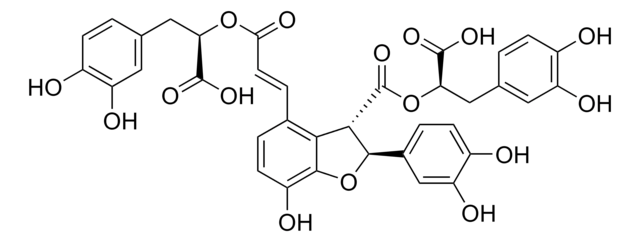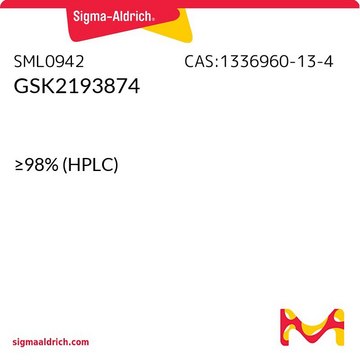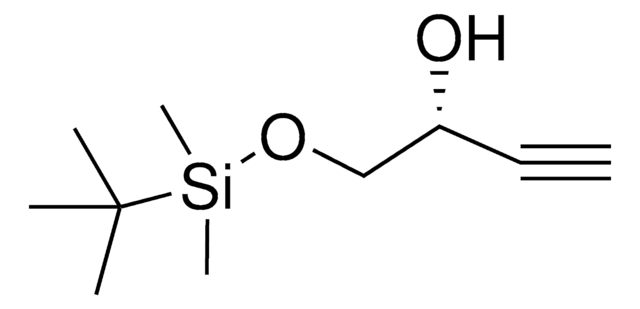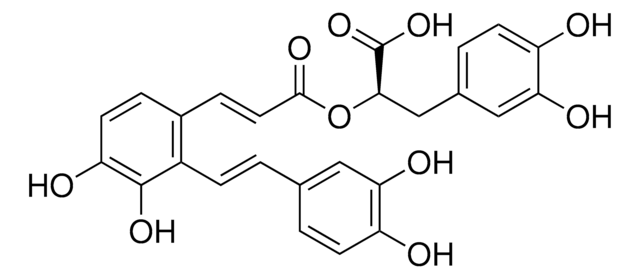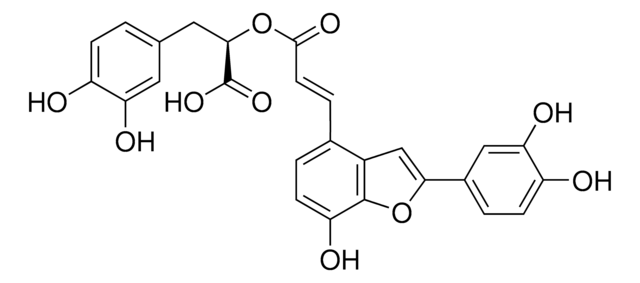SMB01005
Salvianolic acid B
≥85% (LC/MS-ELSD)
Sinonimo/i:
Lithospermic acid B, Salvianic acid B
About This Item
Prodotti consigliati
Origine biologica
plant
Saggio
≥85% (LC/MS-ELSD)
Stato
solid
PM
718.61
Colore
light yellow to brown
Solubilità
water: soluble
applicazioni
metabolomics
vitamins, nutraceuticals, and natural products
Temperatura di conservazione
−20°C
Stringa SMILE
O1[C@H]([C@@H](c4c1c(ccc4\C=C\C(=O)O[C@H](Cc5cc(c(cc5)O)O)C(=O)O)O)C(=O)O[C@H](Cc3cc(c(cc3)O)O)C(=O)O)c2cc(c(cc2)O)O
InChI
1S/C36H30O16/c37-20-6-1-16(11-24(20)41)13-27(34(45)46)50-29(44)10-5-18-3-9-23(40)33-30(18)31(32(52-33)19-4-8-22(39)26(43)15-19)36(49)51-28(35(47)48)14-17-2-7-21(38)25(42)12-17/h1-12,15,27-28,31-32,37-43H,13-14H2,(H,45,46)(H,47,48)/b10-5+/t27-,28-,31-,32+/m1/s1
SNKFFCBZYFGCQN-PDVBOLEISA-N
Descrizione generale
Applicazioni
Azioni biochim/fisiol
Caratteristiche e vantaggi
- High quality compound suitable for multiple research applications
- Compatible with HPLC and mass spectrometry techniques
Altre note
Codice della classe di stoccaggio
11 - Combustible Solids
Classe di pericolosità dell'acqua (WGK)
WGK 3
Punto d’infiammabilità (°F)
Not applicable
Punto d’infiammabilità (°C)
Not applicable
Scegli una delle versioni più recenti:
Certificati d'analisi (COA)
It looks like we've run into a problem, but you can still download Certificates of Analysis from our Documenti section.
Se ti serve aiuto, non esitare a contattarci Servizio Clienti
Possiedi già questo prodotto?
I documenti relativi ai prodotti acquistati recentemente sono disponibili nell’Archivio dei documenti.
Il team dei nostri ricercatori vanta grande esperienza in tutte le aree della ricerca quali Life Science, scienza dei materiali, sintesi chimica, cromatografia, discipline analitiche, ecc..
Contatta l'Assistenza Tecnica.